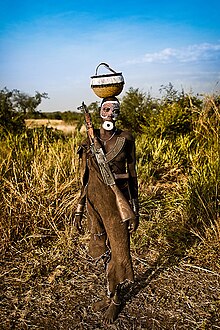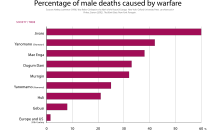Ritual warfare


| Part of a series on |
| War |
|---|
Ritual warfare (sometimes called endemic warfare) is a state of continual or frequent warfare, such as is found in (but not limited to) some tribal societies.
Description
Ritual fighting (or ritual battle or ritual warfare) permits the display of courage, masculinity, and the expression of emotion while resulting in relatively few wounds and even fewer deaths. Thus such a practice can be viewed as a form of conflict-resolution and/or as a psycho-social exercise. Native Americans often engaged in this activity, but the frequency of warfare in most hunter-gatherer cultures is a matter of dispute.[1]
Examples
Warfare is known to every tribal society, but some societies develop a particular emphasis of warrior culture. Examples includes the
Communal societies are well capable of escalation to all-out wars of annihilation between tribes. Thus, in
The Yanomami of Amazonas traditionally practiced a system of escalation of violence in several discrete stages.[citation needed] The chest-pounding duel, the side-slapping duel, the club fight, and the spear-throwing fight. Further escalation results in raiding parties with the purpose of killing at least one member of the hostile faction. Finally, the highest stage of escalation is Nomohoni or all-out massacres brought about by treachery.
Similar customs were known to the
See also
- Captives in American Indian Wars
- Communal violence
- Flower war
- Irregular warfare
- Mock combat
- Napoleon Chagnon
- Prehistoric warfare
- Religion and violence
- Sudanese nomadic conflicts
- Ethnic violence in South Sudan
- Oromo–Somali clashes
- Tinku
- War dance
References
- ^ "The Absence of War". open Democracy. 2003-05-21. Retrieved 2008-05-25.
- ^ ISBN 978-0-670-02481-0.
- ^ "Papua New Guinea massacre of women and children highlights poor policing, gun influx". ABC News. 11 July 2019.
- ISBN 978-1-4179-3181-1.
- ISBN 978-0-8014-1398-8.
- ISBN 978-0-202-01039-7.
Further reading
- Zimmerman, L. The Crow Creek Site Massacre: A Preliminary Report, US Army Corps of Engineers, Omaha District, 1981.
- Chagnon, N. The Yanomamo, Holt, Rinehart & Winston,1983.
- Keeley, Lawrence. War Before Civilization, Oxford University Press, 1996.
- Pauketat, Timothy R. North American Archaeology 2005. Blackwell Publishing.
- Wade, Nicholas. Before the Dawn, Penguin: New York 2006.
- S. A. LeBlanc, Prehistoric Warfare in the American Southwest, University of Utah Press (1999).
- Guy Halsall, 'Anthropology and the Study of Pre-Conquest Warfare and Society: The Ritual War in Anglo-Saxon England' in *Hawkes (ed.), Weapons and Warfare in Anglo-Saxon England (1989), 155–177.
- Diamond, Jared. The World Until Yesterday: What Can We Learn from Traditional Societies?, Viking. New York, 2012. pp. 79–129
